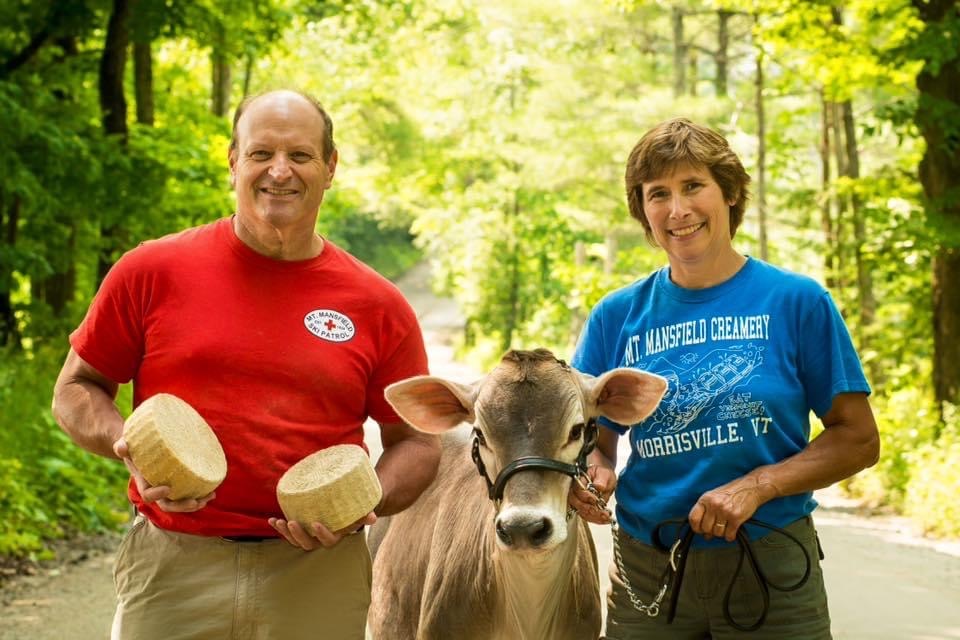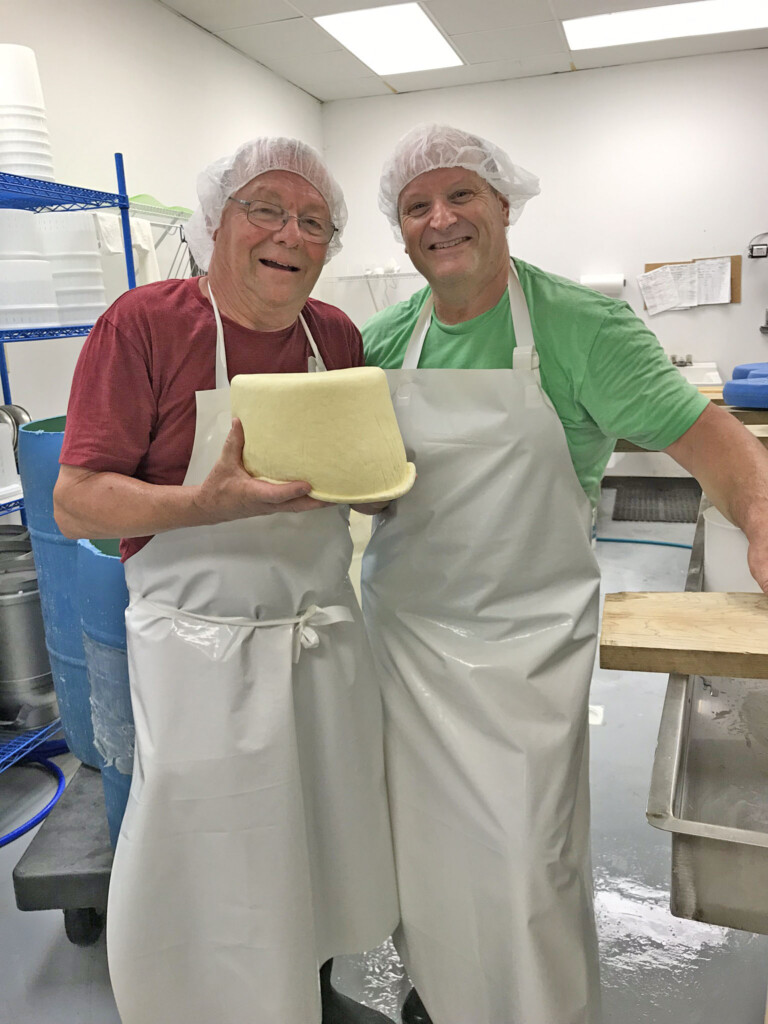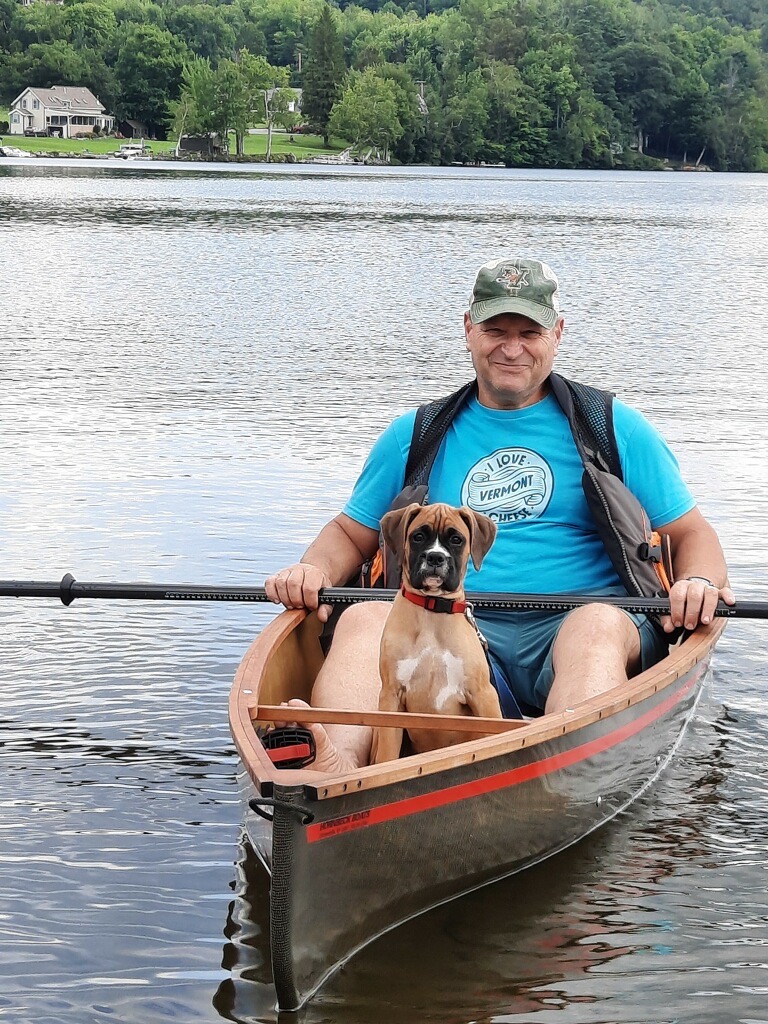
Stan Biasini & his wife Debora Wickart
Today we’ll catch up with Stan Biasini of Mt. Mansfield Creamery! Stan came to cheesemaking after a 25-year career laying carpet. In fact, he was laying carpet in the building in downtown Morrisville that was the original location of the United Farmers Creamery when he revealed to the contractor who owned the building that he was contemplating a career change. “I mentioned that I wanted to retire from carpet work and start a small-scale cheese operation. He and I met after work at his facility, and we designed a cheesemaking room in his woodworking shop. He then proceeded to go online and find out about a cheese cave.” And thus Mt. Mansfield Creamery, now located in that historic building, was born.
“I started with a 40-gallon steam kettle hooked up to a hot water heater and started to make cheese. I took a two-day cheese class at Consider Bardwell with Peter Dixon. I had a grant from Success on Farms through the Intervale with Mark Cannella; it helped me not only with education but also my business plan!” In Mt. Mansfield’s third year in business, a second cheese cave was added to the basement, which is 12 feet underground.
Stan’s new career in cheesemaking was not his first exposure to the world of fine food; he attended Paul Smith’s College in the Adirondacks to be a chef. Nor was it his first foray into the dairy world. “When my wife and I got married 30 years ago, we went around Vermont and purchased 30 cows from different dairy farms. At the time they were all Holstein cows. We renovated a barn outside of Hyde Park Village, and from there we started milking cows. My wife had a degree in dairy sciences from the University of Vermont, and she has always had a passion from a very young age of working with cows. As a young girl, she would walk across the field and help the neighbor milk their cows after school.”
We asked Stan about a typical day on his farm. “A typical day starts at 6:00 a.m. I draw the milk from the bulk tank into milk cans and carry them in the back of my van. [Note: Bulk tanks are used to collect and store milk on farms when milking animals before the milk is used elsewhere, and milk cans are one method used for transporting milk.] From there, I transport the milk to the creamery in downtown Morrisville. I add the cultures and start raising the milk temperature to 70° by 9:00 [the milk is stored at lower refrigeration temperatures before this point]. Then I am adding rennet and figuring out when it’s time to cut the curds. I’m usually done making cheese about 1:00 p.m. and then wait for the pig farmer to pick up the whey, which we pump it into a trailer.” When Stan says “done making cheese”, what he means is that he’s done making cheese into wheels … once formed into wheels, the cheese goes into his aging caves for weeks, months, or years before its flavor and texture are “ready” for sale!
If anyone can tell you the parallels between laying carpet and cheesemaking, it is Stan. “The hardest part about cheesemaking is the physical demands. The dream job of standing on concrete for 6 to 8 hours, climbing up and down the stairs, and bending over the cheese–that can be very taxing on the body. After 15 years of making cheese and after 25 years of laying carpet, my body is feeling the effects.”
But Stan also finds there’s a lot to love about his second career. “The best part about being a cheesemaker is the connections I have made with fellow cheesemakers and with the folks who purchase our cheese at the farmers’ markets. The people who have purchased our cheese have become more like family. Many times we talk more about skiing and other activities, and just sample cheese and chitchat. I would certainly have to say my favorite part of making cheese is when folks taste our cheese and realize why it is so special.”
For many small cheesemakers like Stan, cheesemaking can be a solitary endeavor. One of the ways Stan finds a social balance is skiing. “In the winter time, I am a Ski Instructor at Stowe on a part-time basis. I have met many people in the Ski School who also do summer sports like paddleboarding, biking, as well as canoeing. In the summertime, I enjoy camping and cooking over the fire. I am also an avid tennis player where I belong to a club and try to play once a week.”
Finally, we asked Stan for the best piece of advice to give to a new cheesemaker. “I guess the best advice I have ever given somebody was about affinage in the caves.” Affinage is the term used to describe when a cheesemaker manages a cheese as it ages – which may require turning, flipping, salting, and brushing wheels on a regular basis while the cheese ages.
“I feel from being a chef that the affinage portion of cheesemaking is many times overlooked by small-scale cheesemakers. I feel that is one of the most important aspects of our cheeses. As a chef, you’re always looking for cheeses that are presentable on the cheese plate. With our cheeses, you can eat the rind of our cheeses and many people think there is added flavor in those rinds.”

Stan Biasini with Cheesemaker Jean-Paul Robert of Alsace, France. Jean-Paul is a cheesemaker who visited Stan in August 2019. About this photo, Stan said: This photo is one of my favorites! Famous French cheesemaker; we made cheese, ate cheese and drank wine! I have the last wheel for this summer! 5 years old!

